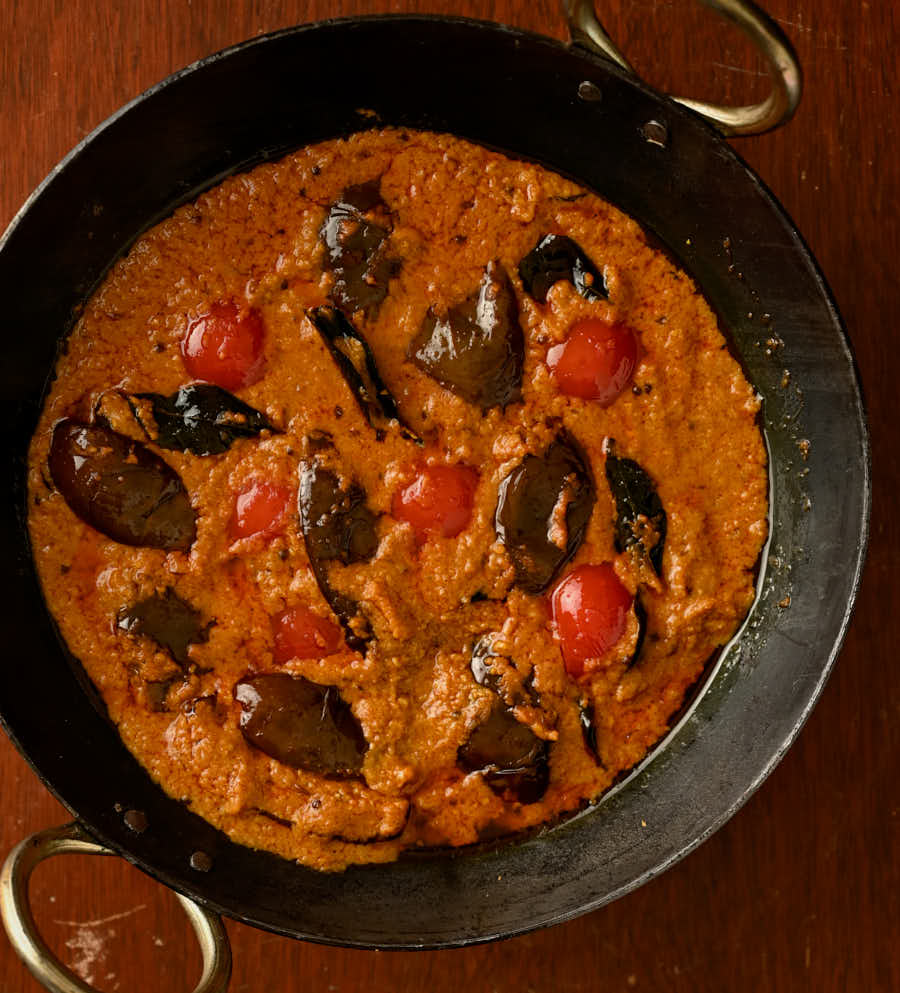Baghara baigan is one of Hyderabad’s most famous and luscious sweet-and-sour vegetarian dishes. It calls for small eggplants that are partially quartered lengthwise, stuffed, fried, and then put in a sauce filled with roasted and ground sesame seeds and nuts, along with dozens of other roasted, fried, strained, or grated seasonings. It is delicious, but complicated to make. I wanted to make a version that was much simpler but just as delicious, and here is the result.
I have cut down its numerous steps, which may be heretical, but it works beautifully. There are still a great many ingredients involved, but the cooking itself is simple.
This is a perfect dish for parties, served with a rich pilaf and other vegetable dishes.
SERVES 6
• 2 lbs. medium Italian eggplants (I used 3)
• 8 tablespoons olive or peanut oil
• 1 tablespoon peanut butter (freshly ground is best)
• 1 tablespoon tahini (roasted sesame paste, sold in many supermarkets)
• 1 tablespoon tomato purée
• 2 tablespoons dark brown sugar
• 1½ teaspoons tamarind concentrate (sold in bottles)
• ½ teaspoon whole brown mustard seeds
• ½ teaspoon whole cumin seeds
• 6–8 fresh curry leaves, lightly crushed in your hand
• 1 large onion (8 oz), peeled and finely chopped
• 1 tablespoon peeled and finely grated fresh ginger
• 1 tablespoon peeled and finely chopped garlic
• ¼ teaspoon ground turmeric
• 1 teaspoon ground coriander
• 1 teaspoon ground cumin
• ¼–¾ teaspoon nice red chili powder
• 1¼ teaspoons salt, or to taste
1. Cut the eggplants lengthwise into quarters, then crosswise into 1½ inch pieces.
2. Put 6 tablespoons of the oil in a large nonstick wok, karhai, or frying pan and set over medium-high heat. When hot, add the eggplant pieces and fry until lightly browned. They should be three-quarters cooked through. Using a slotted spoon, transfer them to a bowl.
3. Put the peanut butter and tahini in a separate small bowl. Slowly add 1 cup of boiling water, stirring with a whisk as you do so, until you have a paste. Add the tomato purée, brown sugar, tamarind concentrate, and another 1 cup of boiling water, stirring as you go. Mix well, and set aside.
4. Most of the oil in the pan will have been absorbed by the eggplant. Add 2 tablespoons of oil to whatever is left and set over medium-high heat. When hot, add the mustard seeds. As soon as they start to pop, in a matter of seconds, add the cumin seeds and let them sizzle for a few seconds. Now add the curry leaves (take care, as these will splutter) and, a second later, the onions. Stir and fry for about 3 minutes, or until the onions just start to brown. Turn the heat to medium-low and stir-fry for another 2–3 minutes.
5. Add the ginger and garlic. Continue to stir and cook for 2 minutes. Add the turmeric, coriander, cumin, and chili powder. Stir for a minute, then add 1 cup of water. Cook on low heat for 8–10 minutes.
6. Add the peanut sauce and cook gently, stirring all the time, for 5 minutes. Add the eggplant and the salt. Cook for another 10 minutes or so on low heat, stirring gently now and then, until the eggplant pieces are soft but still whole. If the sauce feels too thick, feel free to add water at any time, especially when you are reheating the dish. There should always be some thick sauce in the pan.








